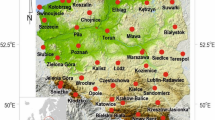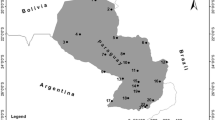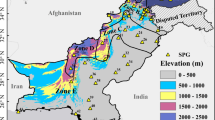Abstract
The results from three methods aimed at improving precipitation type (e.g., rain, sleet, and snow) estimation are presented and compared in this paper. The methods include the threshold air temperature (AT), threshold wet bulb temperature (WBT) and Koistinen and Saltikoff (KSS) methods. Dot graphs are plotted to acquire the threshold air temperature or the threshold wet bulb temperature using daily averaged air temperature, wet bulb temperature and precipitation data at 643 stations from 1961 to 1979 (precipitation types are not labeled in the database from 1980 to present) in China. The results indicate that the threshold AT or WBT methods are not able to differentiate rain, sleet and snow in the most regions in China; sleet is difficult to differentiate from other precipitation types based on the two threshold methods. Therefore, one threshold AT and WBT method was used in this study to differentiate rain and snow. Based on Gaussian-Kriging interpolation of threshold air temperature (T 0) and wet bulb temperature (T w), the T 0 and T w contour lines and contour surfaces are calculated for China. Finally, a comparison between the KSS, AT and WBT methods are provided in which the KSS method is calculated based on air temperature and relative humidity. The results suggest that the KSS method is more appropriate for water phase estimation than are the other methods; the maximum precision for rain and snow is 99% and 94%, respectively. The AT method performs better than the WBT method when the critical air temperature is 2°C.
Similar content being viewed by others
References
Arnold JG, Srinivasan R, Muttiah RS, et al. (1998) Large area hydrologic modeling and assessment part I: model development. Journal of the American Water Resources Association 34(1): 73–89. DOI: 10.1111/j.1752-1688.1998.tb05961.x
Bergström S (1995) The HBV Model. In: Singh VP (ed.), Computer models of watershed hydrology. Water Resources Publications, Highland Ranch. pp. 443–476.
Bocchieri JR (1980) The objective use of upper air sounding to specify precipitation type. Monthly Weather Review, 108: 596–603. DOI: 10.1175/1520-0493(1980)108〈0596:TOUOUA〉2.0.CO;2
Bourgouin PA (2000) Method to Determine Precipitation Types. Weather and Forecasting 15: 583–592. DOI: 10.1175/1520-0434(2000)015〈0583:AMTDPT〉2.0.CO;2
Brooks CF (1920) The nature of sleet and how it is formed. Monthly Weather Review, 48: 69–73.DOI: 10.1175/1520-0493(1920)48〈69b:TNOSAH〉2.0.CO;2
Chen RS, Lu SH, Kang ES, et al. (2008) A distributed waterheat coupled model for mountainous watershed of an inland river basin in Northwest China (I) model structure and equations. Environmental Geology 53: 1299–1309. DOI: 10.1007/s00254-007-0738-2.
Czys RR, Scott RW, Tang KC, et al. (1996) A physically based, nondimensional parameter for discriminating between locations of freezing rain and ice pellets. Weather and forecasting 11: 591–598. DOI: 10.1175/1520-0434(1996)011〈0591:APBNPF〉2.0.CO;2.
David-Labor E, Heilig M (2004) Hydrologische Prognosen in Niederösterreich. Wiener Mitteilungen 164: 101–112.
DHSVM version 3.0. http://www.hydro.washington.edu/Lettenmaier/Models/DHSVM/index.shtml.
Gjertsen U, Ødegaard V (2005) The water phase of precipitation — a comparison between observed, estimated and predicted values. Atmospheric Research 77(1–4): 218–231. DOI: 10.1016/j.atmosres.2004.10.030.
Kang E, Cheng G, Lan Y, et al. (1999). A model for simulating the response of runoff from the mountainous watersheds of inland river basins in the arid area of northwest China to climatic changes. Science in China Series D: Earth Sciences 42(1): 52–63.
Koistinen J, Saltikoff E (1998) Experience of customer products of accumulated snow, sleet and rain. In: Advanced weather radar systems, COST 75 Int. Seminar, Locarno, Switzerland. pp 397–406. [Available from European Commission, B-1049 Brussels, EUR 18567 EN]
Koolwine T (1975) Freezing rain. M.S. thesis, Dept. of Physics, University of Toronto. p 92. [Available from University of Toronto Libraries, 27 King’s College Circle, Toronto, ON M5S 1A1, Canada]
Levizzani V, Bauer P, Turk FJ (2007) Measuring precipitation from space: EURAINSAT and the future. Dordrecht, Advances in Global Change Research 28: 655–674.
Liang X, Wood EF, Lettenmaier DP (1996) Surface soil moisture parameterization of the VIC-2L model: valuation and modification. Global and Planetary Change 13(1–4): 195–206. DOI: 10.1016/0921-8181(95)00046-1
Penn S (1957) The prediction of snow vs. rain. Forecasting Guide 2, U.S. Weather Bureau. p 29. [Available from NOAA Central Library, 1315 East-West Highway, Silver Spring, MD 20910]
Refsgaard A, Seth SM, Bathurst JC, et al. (1992) Application of the SHE to catchments in India-Part 1: General Results. Journal of Hydrology 140:1–23. DOI: 10.1016/0022-1694(92)90232-K
Schuur TJ, Park HS, Ryzhkov AV, Reeves HD (2012). Classification of precipitation types during Transitional Winter Weather Using the RCU Model and Polarimetric Radar retrievals. Journal of Applied Meteorology and Climatology 51: 763–779.
Stewart R (1985) Precipitation Types in winter storms. PAGEOPH 123: 597–609.
Wagner JA (1957) Mean temperature from 1000 mb to 500 mb as a predictor of precipitation type. Bulletin of the American Meteorological Society 38:584–590.
Wigmosta MS, Vail L, Lettenmaier DP (1994) A distributed hydrology-vegetation model for complex terrain. Water Resource Research 30: 1665–1679. DOI: 10.1029/94WR00436
Author information
Authors and Affiliations
Corresponding author
Rights and permissions
About this article
Cite this article
Chen, Rs., Liu, Jf. & Song, Yx. Precipitation type estimation and validation in China. J. Mt. Sci. 11, 917–925 (2014). https://doi.org/10.1007/s11629-012-2625-x
Received:
Accepted:
Published:
Issue Date:
DOI: https://doi.org/10.1007/s11629-012-2625-x




